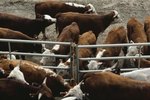When it comes to feeding your animals, you want the most nutritionally balanced hay you can find for their diets. Though you may not feed your animals one specific hay, finding out the value of the nutrients in each individual hay could help determine the percentage of each hay you add to their daily diets. Also, different animals require different nutrients, so knowing the nutritional value can help you determine the types of hay you use for specific animals.
Timothy Hay

Timothy hay is suitable for growth in cooler climates. It also adapts extremely well to different soils. Timothy hay is a grass hay and yields 7 to 11 percent crude protein and 0.38 to 0.51 percent calcium. The digestible energy of this type of hay ranges from 0.82 to 0.94 megacalories (Mcal) per lb. Timothy hay is time sensitive, so you must cut the grass at the exact right time. If you cut it cut before or after maturation, the nutritional value will deteriorate.
Alfalfa Hay
Alfalfa hay is an ideal source for animals because it is full of rich nutrients. This legume type of hay has a crude protein content between 17 and 20 percent, and it has 1.19 to 1.41 percent calcium and 0.98 to 1.13 mCal/lb. digestible energy. Protein is necessary for tissue growth in young animals, and alfalfa hay may promoter greater development.
Oaten Hay
Oaten hay is hay made from oat harvests not used for grains. Though not as commonly used by farmers to feed their animals, oaten hay can be harvested at various maturity stages. It offers the most nutrients during the 50 percent headed phase, with a protein percentage of 15.6 to 16.3 and a calcium percentage of 0.32. Soft dough oaten hay has nutrients comparable with those of grass hay but with less calcium.
Orchard Grass Hay
Orchard grass hay is another type of grass hay similar to timothy hay. However, this hay is not time sensitive when it comes to nutritional content. It can be cut during early maturation stages, yielding a higher-nutritional quality hay for your animals.
Though this grass isn't time sensitive, it reaches maturation during a season not favorable to farmers. Orchard grass hay yields a crude protein between 8 and 13 percent and has a calcium content of 0.26 to 0.27 percent.
References
Photo Credits
-
Jupiterimages/Photos.com/Getty Images
Writer Bio
Kellie Davis graduated magna cum laude from Florida Gulf Coast University, earning a B.A. in English. She is a full-time sports nutrition writer, fitness blogger and freelance copywriter.




